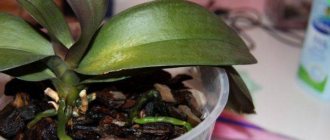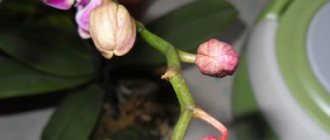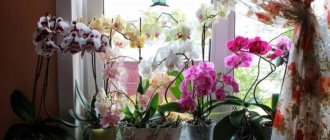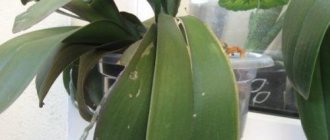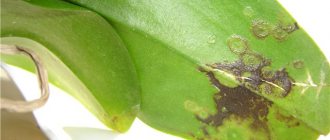Diagram of the structure of the phalaenopsis orchid
The structure of an orchid differs from other indoor plants in appearance, so the flower requires certain knowledge of care and cultivation. Before purchasing phalaenopsis, you should familiarize yourself in detail with the structure of the plant, features of care and breeding. An orchid consists of a root system, stem (trunk), leaves and the flower itself.
Roots
The root system has some differences depending on the type of orchid. However, in any case, it performs the following functions:
- with its help, the flower is attached to the substrate or trees, rocks in the natural environment;
- participates in plant photosynthesis;
- absorbs water and nutrients.
Some types of orchids may have aerial roots. One of the representatives of such a flower is the phalaenopsis orchid.
stem
All members of the family are divided into two groups depending on the method of branching of the shoot. If the shoot has only one growth point and develops upward, then this method is called monopodial. When the shoot develops in a horizontal direction, we can talk about the sympodial method of branching. Thus, the stem of an orchid is essentially a vertical shoot. It can be both long and short.
Leaves
Orchid leaves vary in shape, color and structure. It depends on the type of plant and habitat. Orchids growing in the shade have thin leaves, while those in the sun have thicker leaves with a dense structure. Often the leaves reach 1 meter in length. During the dry period, they absorb water and accumulate it in the leaves, thereby adapting to difficult environmental conditions.
Flower
The orchid flower is extremely beautiful, its structure is quite complex. The bright and wide elements of the flower are sepals (sepalia) modified over time. Their shape, color and size depend on the type of plant. Sepals alternate with petals, which are petals, and differ in color. In the very center of the flower there is a formation that is found only in orchids - the lip or labellum. Its function is to attract pollinating insects to the flower.
Feeding
If you follow all the above recommendations, caring for your dendrobium orchid will be easy. In addition to watering and spraying, it will need to be fertilized.
You need to be careful with fertilizing and adhere to the principle “it’s better to underfeed than to overdo it.” Orchids get sick from excess fertilizer and may even die.
They are fed foliar (by spraying) and root (regular, in the ground). They need to be alternated. It is best not to do it on your own, making up a nutrient mixture, but to purchase special fertilizers for orchids at flower shops. They must contain nitrogen and phosphorus.
Flower growers recommend spraying plants with a growth stimulator once a month.
If the dendrobium orchid has faded and live buds are visible on the pseudobulb, then pruning cannot be done. In other species, you need to look to see if the peduncle has begun to dry out. If yes, then it needs to be removed.
Root system
The root system is an important part of the flower, which performs a number of complex functions. The roots are usually white. They consist of a special substance, velamen, which contains dead cells and is filled with air. This structure of the root system resembles a sponge and helps the plant accumulate water and develop in unfavorable conditions. The longer the drought, the thicker the plant’s velamen layer. Flower roots can be primary or adventitious.
Main
The main type of orchid root system can be seen in a pot, since this plant is grown in a transparent container. When purchasing, you need to pay attention to the roots: they should not contain mold or rot.
Subordinate clause
The accessory type of phalaenopsis root system is also called aerial. Such roots can grow on any part of the plant. With their help, the orchid attaches itself to nearby crops, without interfering with their development, that is, without parasitizing at their expense. These plants are called epiphates. For some reason, they cannot establish themselves in the soil and obtain nutrients through photosynthesis. The leaves and roots of the orchid take part in this process. Thanks to adventitious roots, the plant is able to absorb moisture directly from the air. Externally, such roots appear as thick shoots.
Care
At home, a tropical plant requires special care.
Important! The leaves of the exotic beauty must be regularly wiped with a damp cloth to remove dust. The flower must be sprayed - preferably 5 times a day, excluding the flowering period.
It is advisable to use filtered, clean water at a temperature of 35-40ºС for irrigation. Orchids love humidity, preferably 50-60%. It is not recommended to place the flower pot on the sunny side. Direct sunlight can burn the leaves.
It is necessary to inspect the foliage weekly for insect damage.
Flower
An orchid flower is formed from a peduncle that grows from a certain axil between the leaves and the trunk of the plant. The peduncle changes annually; indoors it grows in autumn or spring. If at some point the formation of a peduncle does not occur, this often means that the orchid does not have enough sun and light. The peduncle dries out after the flowers fall.
A distinctive feature of the phalaenopsis flower is its central symmetry, when the six parts of the flower are arranged in two circles. The flowers have a variety of shapes, ranging in size from 1 to 20 cm.
What leaf color is abnormal?
The color of orchid leaves is green, the shade depends on the variety and living conditions of the plant, but green is always a healthy color.
- Yellowing indicates that the plant is withering or drying out. This may be due to improperly selected care. Also, too much fertilizer can cause yellowing of the leaves.
- Purple spots indicate that the orchid has been exposed to the sun for a long time and has received a sunburn.
- A red tint indicates that there is excessive lighting in the room.
- A brown color is a sure sign that the plant is infected with a disease.
- White or discolored areas with a brown outline indicate sunburn.
- Light areas that then begin to turn red may indicate the presence of a disease such as rust.
- Yellow rings and spots can indicate the presence of a viral disease.
Pseudobulb
Bulbs are certain formations that are found only in orchids of the sympodial type. This is a reduced shoot that collects moisture and nutrients. The pseudobulb is the same, but is formed in an ovoid, oval, cylindrical shape, while the bulb resembles an onion. Despite the fact that these formations are not shoots of the plant, sometimes buds, leaves and even aerial roots appear on them.
What to do with a faded peduncle?
In many orchids, flower stalks are removed after the plant loses its last flowers, without waiting for them to dry. For example, in cattleya, cymbidium or oncidium, these stems are cut off after flowering .
In some species of dendrobium, after the flowers have faded, removal is not carried out . In the future, children will develop on such branches, which can be planted - this is how young plants will begin their life.
Not all orchids have their flower stalks cut off after flowering.
Phalaenopsis is the most popular orchid. It is enough to carefully examine the appearance of the peduncle to understand whether it needs pruning:
- If it begins to darken, becomes brownish or black, it is removed;
- And when it retains its green color, there is no need to remove it .
On such faded stems, dormant buds may eventually wake up, the peduncle will lengthen and the plant will bloom again .
How to wake up a sleeping kidney
The bud in a dormant state is located on the peduncle, at its base or in the middle. If it can be awakened artificially, then a full-fledged orchid baby can be raised.
Before starting work, you need to determine the temperature in the room. It must be at least 22°C. On the peduncle in its middle part, select about 4 nodes and cut off the scales with a knife. Lubricate the cleaned kidney with any drug that accelerates growth. After about a month, small rosettes consisting of 2-3 leaves should appear in this place. Later, roots appear on them and when they reach 2 cm, the baby needs to be cut off and transplanted into a transparent pot with substrate. Under favorable conditions and proper care, the orchid will bloom within a year.
Dendrobium orchid species
Let us repeat that there are over 1000 species in the Dendrobium genus. Let's name some of them:
- Dendrobium Parisha. It has powerful thickened stems that can be erect or hanging. They grow up to 40 cm in length. Each such stem is thickened at the nodes and is shrouded in a white base of leaves. They are oblong in the Parish dendrobium orchid, with a slightly notched tip. The flowers of this species are large, up to 100 mm in diameter. The petals are pink or lilac. The color towards the edge is always more saturated than in the middle. The lip of this orchid can be round or diamond-shaped, lighter than the petals. It has two contrasting spots at the base.
- Lindley's Dendrobium. This orchid has short (up to 8 cm), bulb-like stems. Each has only one large leathery leaf. The plant's peduncles are long, hanging, the flowers are yellow, very fragrant, with a pubescent lip.
- King's Dendrobium. This orchid is distinguished by rigid stems that become thinner towards the top. It grows up to 30 cm in length. The raceme is sparsely flowered and consists of small fragrant flowers of various shades - from white to purple. The lip of this orchid is interesting. It has three blades. In this case, the sepals are fused.
- Dendrobium nobile. This orchid is given the epithets “magnificent”, “noble”, “noble”. This variety of dendrobium orchid has many varieties and hybrids. You can admire their beauty tirelessly. Its flowers can come in all sorts of shapes and colors, white, pink, purple, speckled and striped. At the same time, the lips of flowers are always very bright, contrasting, they can be smooth and fringed, with or without spots. The leaves of representatives of the species are mostly sessile, arranged in pairs or alternately. The stems are powerful and erect. The Dendrobium Nobile orchid will be a charming decoration for any home.
Rest period
After flowering, the plant begins a dormant period . It is important to properly care for your orchid at this time:
- For some types of orchids, reduce watering:
- Vand;
Zygopetalum;
- Dendrobiums;
- Cattleya;
- Miltonius;
- Cymbidiums;
- And oncidiums.
- Almost all orchids should be provided with a difference in day and night temperatures, for some species up to 10°C, and a sufficient amount of sunny color;
- Often, after trimming the peduncle, an orchid needs to be replanted , because the store-bought substrate cakes over time and loses its value.
For Phalaenopsis the water regime does not change ; it depends on the time of year. once a week at this time ;
During the dormant period, the orchid must be properly cared for.
If a houseplant does not stop actively growing leaves, young roots or new flower arrows appear, it means that its active development phase continues . In this case, care is not adjusted.
Phalaenopsis - capable of repeated flowering
Phalaenopsis is considered the most unpretentious of all orchids grown in indoor floriculture. It’s not for nothing that people called it “the orchid for beginners.” The flower is native to the Philippine Islands, but this does not prevent it from growing safely as a houseplant in the middle climate. True, it would be wrong to say that caring for phalaenopsis is easy. Rather, it is within the capabilities of a beginner who is ready to acquire new knowledge and experience.
The name of the plant comes from the Greek words "fhalaina" (night butterfly) and "opsis" (resemblance). Take a closer look, the flowers of this orchid really resemble moths sitting on a stem to rest.
Advantages. This genus of orchids is one of the most numerous among those that are actively grown at home. There are more than 70 natural species of phalaenopsis and many hybrids. They are all so different that sometimes you can’t even believe that some varieties are “relatives” to each other. But such a large selection allows you to choose exactly the flower that will harmoniously fit into the interior and will delight the eye with unusual blooms.
Phalaenopsis can bloom for 2-3 months, since the plant forms new flowers on old peduncles. In addition, the orchid produces flower arrows throughout the year. Phalaenopsis captivates flower growers because the air temperature at home suits it. The plant feels great at 18-26°C (with a temperature drop of 5°C at night).
Flaws. Most problems with phalaenopsis come down to one reason - the lack of sunlight, which this flower needs all year round. In the orchid's homeland, the light intensity does not change with the changing seasons. Therefore, when growing phalaenopsis at home in an apartment, you should strive to create similar conditions. As a rule, a flower requires 12 hours of daylight. Since in the middle zone you cannot count on such long-term natural lighting (especially in winter), the orchid needs to be supplemented with additional lighting.
Peculiarities. Phalaenopsis orchid is a typical epiphyte. This means that the orchid does not grow in the ground, but on the bark of trees. The plant receives moisture from the air or precipitation, and nutrition from the sun through photosynthesis, in which the roots actively participate. Therefore, unlike other houseplants, phalaenopsis requires a pot and substrate solely for stability.
Phalaenopsis is prone to searching for a light source, that is, it tends to turn and lean in the direction where the light intensity is higher. To prevent the orchid from growing crookedly, it needs to be turned about 2 times a month. This should not be done only if the phalaenopsis has begun to form buds.
Which orchid to choose? Most often, pink phalaenopsis, Luddeman's phalaenopsis, and pleasant phalaenopsis are grown at home. Hybrid phalaenopsis is quite popular, which can bloom throughout the year among experienced gardeners, since this orchid does not have a dormant period.
- Transplanting phalaenopsis at home - step-by-step instructions
Don’t know how to properly replant a home orchid? We'll show you and tell you in detail!
Trimming
For what?
Orchids are an interior decoration ; their appearance should be pleasing to the eye, and dried or faded shoots look unaesthetic.
Most often, an orchid is trimmed for an aesthetic appearance.
Such flower stalks take away a lot of nutrients and moisture that the plant needs so much.
Which is correct?
All manipulations are carried out :
- Garden shears with sharp blades;
- Or a pruning shears.
Before use, they can be heated over a fire or disinfected with alcohol to reduce the possibility of infection of the orchid.
Remove the stem as low as possible , as close as possible to the base of the flower, leaving a small stump of about 2 cm. After the procedure, the cut is disinfected by sprinkling with cinnamon powder or crushed charcoal.
The upper part of a phalaenopsis with a green peduncle , leaving the lower internode with one dormant bud. Sometimes the flower arrow is left completely; it can build up the upper tip.
Mimicry in plants
Nilsson observed that Chelostoma males visit Cephalanthera flowers, apparently expecting to find food there. Not finding nectar inside the flower, they back away and get out of the flower and at the same time touch the pollinia - lumps of clumped pollen. With the help of a sticky secretion secreted by the pistil of a flower, pollinia are attached to the body of the bee. Thus, leaving a flower, a bee takes away its pollen, and visiting another similar orchid, pollinates it. Nilsson found that bees do not distinguish the bell from the pollenhead and successfully pollinate both species. He was interested in why the flowers of this orchid, which look different and do not produce nectar, are attractive to bees?
Nilsson solved this mystery with the help of a spectrophotometer. This device allows you to determine the wavelength of light reflected from an object. It was discovered that the color of pollenhead and bellflower flowers, perceived by humans as different, should look the same to bees, since in that part of the spectrum in which the bee’s eye is sensitive, the reflection curves of these objects almost coincide (Bees, like many insects, are best see in the ultraviolet region of the spectrum and do not distinguish shades of red.) For a bee, therefore, orchid and bell flowers are exactly the same in color, and shape and smell apparently play a lesser role in this case.
So the male Chelosioma visits Cephalanthera flowers by mistake; This behavior of the bee, which is of little use to the insect itself, is very beneficial to the plant: it provides itself with a pollinator without giving anything in return. Determining the reproductive success of the pollenhead in various habitats showed that this orchid clearly increases the degree of fitness by imitating the bell: in those places where the pollenhead coexists with the bell and the bees pollinating it, it produces 6 times more seeds than where it grows in isolation.
There are more bizarre examples of mimicry in the orchid family. Thus, some species imitate female insects. In these species, the flowers do not produce nectar, but they do emit a smell that is remarkably similar to the smell of pheromones secreted by female pollinating insects. Often the lower lip of a flower is similar in shape and texture to the body of the model insect. For example, orchids that attract bees have hairy lips.
Some species of the European genus Ophrys have evolved such close relationships with the insects that pollinate them that they have an odor almost identical to that of the sexual attractants of the females of these insects. Some orchids even get their species name from the name of the insect that pollinates them. Males, especially if they have not yet mated with a female, are attracted to orchid flowers with which they try to copulate. For the plant, this situation, called pseudocopulation, is undoubtedly beneficial, as it ensures cross-pollination. When a male, mistaking an orchid flower for a female, sits on it, he touches the pollinia, which adhere to his body. Not finding what it wants in a flower, the insect flies away and, continuing the search for a female, can visit another plant of the same species and transfer pollen to it.
Pseudocopulation is one of the most complex forms of pollination through animals, in which mimicry is clearly manifested like nowhere else. This strategy has evolved independently in three separate landmasses (Australia, Eurasia, and South America); It is most often observed in the tropics, where many orchid species reproduce in this way. Why do insects that gain nothing from the interaction still participate in it? Why did natural selection not promote the survival of those males who could distinguish the female of their species from the flower of the plant and did not waste energy on pseudocopulation? One possible explanation is that the timing of the plant's flowering coincides with the emergence of adult male insects. (In insects, males often emerge from the pupa before females.) Males compete for the few adult females that are available at this time. It is believed that in such circumstances the ability of males to distinguish females is very low. In a state of sexual frustration, many males are readily deceived by the appearance and smell of orchid flowers.
Compared to pseudocopulation, which is associated with eye-catching and decorative - from a human point of view - signs of flowers, a striking contrast is made by another pollination strategy, in which the plant takes on the characteristics of rotting meat: a putrid odor, blood-red color and numerous hairs - which seems disgusting to humans , but attracts flies and other insects that feed on carrion. One of the most striking examples of such mimicry is Amorphophallus titanum, growing on the island of Sumatra; This plant, reaching 2.5 m, has such a smell that it is said that you can lose consciousness if you inhale it from too close a distance.
Such plants rarely provide nectar or other rewards to pollinators. Instead, they deceive them with their external appearance, similar to a substrate suitable for the development of the larvae of these insects. Female insects, whose larvae feed on the tissues of dead animals, are deceived by the smell of rotting meat and land on these flowers, and sometimes even lay eggs in them. And just as the males of some insects fly from flower to flower in search of females, so the females of other insects do this in search of a place to lay eggs. Visiting flower after flower, they involuntarily collect pollen on their bodies and transfer it to the stigmas of the pistils, thus pollinating the plants.
Some plants imitate individuals of their own species, but of a different sex. This strategy is called Bakerian mimicry, named after the researcher Herbert G. Baker, who first described this phenomenon. It is known that plants of the Caricaceae family (to which, for example, papaya belongs) are dioecious, i.e., male and female flowers develop on different individuals. In Caricaceae, male and female flowers differ significantly from each other; This phenomenon is called sexual dimorphism. In male flowers of plants of this family, the petals form a long tube, and in female flowers, free, unfused petals surround a large green ovary. In addition, male flowers secrete nectar, while female flowers do not.
Baker became interested in how these species pollinate. What attracts insects to female flowers that produce neither nectar nor pollen? While studying the interaction of papaya plants with their pollinators, he noticed that pollination is carried out mainly at dusk by butterflies from the family Sphingidae, visiting both male and female flowers. The scientist hypothesized that to these butterflies, which fly in low light, female and male papaya flowers look essentially the same, so they mistakenly visit the female flowers even though they do not produce nectar. Baker called this phenomenon "pollination by mistake."
In most dioecious species, the number of flowers on male plants is usually greater than on female ones. K. Bawa suggested that the unequal number of flowers of different sexes in such plants arose as a result of intensive selection among female flowers, which should have the appearance desired by pollinating insects visiting male flowers. This type of false similarity is consistent with the rules of mimicry: the model (in this case a male flower) must be represented by a greater number than its imitator (here a female flower). For this reason, we can think that mimicry in dioecious plants is much more widespread than previously thought. It is interesting to note that male and female flowers in animal-pollinated plants are usually similar, while in wind-pollinated plants they are often different.
Where is the growth point of the hatching arrow?
An orchid shoots a peduncle from the leaf axil, but there are times when it hatches from the growing point ; this is not critical, since it does not harm the health of the seedling. However, when the plant blooms again, it may appear from the waiting bud of an old shoot. In this case, the peduncle can grow not only upward, but also to the side.
When a peduncle appears from the main stem and grows sideways, as a rule, a minimum number of buds appears, and in order for them to form and grow faster, it is recommended to follow the rules of care.
Bulba
This interesting name was given to special formations that are found only in sympodial orchids. They are a thick, powerful shoot that acts as a reservoir for moisture and nutrients. Moreover, the word “bulba” itself translated from Latin means “onion”. It is noteworthy that, in addition to such formation, there are also so-called pseudobulbs. They are the same growths, performing the same role, but having a different appearance. Pseudobulbs can be ovoid, oval or even conical. However, both types have a common name - tuberidium. They appear from vegetative shoots of the rhizome. In fact, bulbs are shoots of a special shape. They also form buds and form leaves.
